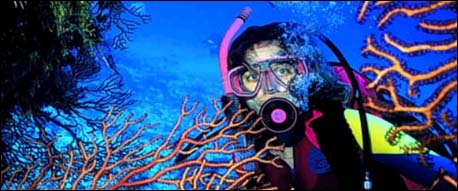
Magazines
SPONSORED
LINKS
Scuba
Scuba stands for self-contained underwater breathing apparatus. Scuba divers carry a tank of air that allows them to breathe while deep underwater.
Scuba Diving
 History
History
A knowledge of the contributions of deep sea divers in
years gone by is necessary for us to truly appreciate
our ability to take to the blues in the new millennium.
Our debt to our predecessors can only be paid if we
continue their quest for knowledge and diving
experience.
The earliest reference to underwater diving techniques
occurs in the manuscripts of the Greek philosopher
Aristotle, which refer to a diving bell used by forces
of Alexander the Great to clear the harbor at Tyre in
332 BC. This contraption, shaped like a bell, was
actually a large wooden barrel that a diver could place
over the head and upper body while walking on the bottom
of the sea. Underwater, the pressure of the air trapped
inside the barrel displaced any water that might enter.
This displacement created an airspace where the diver
could breathe and see.
In 1716, English astronomer Edmond Halley invented a
bell that allowed divers to stay at about 60 ft (18 m)
for an hour and a half. His bell consisted of a wooden
shell with windows to admit light from the surface. Air
was supplied to divers through leather tubes connected
to air casks that could be lowered into the water as
needed. As the casks were lowered below the bell,
increasing water pressure forced air up through the
tubes into the upper part of the diving bell where the
divers could inhale it.
These early inventions led to the development of more
sophisticated diving bells that are used today. Modern
diving bells are constructed of materials such as steel
that can withstand extreme water pressure at lower
depths. They also have communication systems that link
them to the surface, and lighting and heating systems
that provide divers with a comfortable working
environment. These bells are a means of working on the
underwater portions of bridges, piers, and jetties.
Diving bells are also used to transport commercial
divers to their underwater workstations.
Equipment now used for scuba diving began to appear in
the 1800s. In 1819 German inventor August Siebe
developed the first diving suit-a copper helmet attached
to a canvas and leather suit. Hoses supplied air to the
diver by a surface pump. The hoses were attached to the
helmet, and the pressure the air provided kept the water
level below the diver's chin. Weights worn around the
chest kept the diver from rising to the surface when
more air was supplied to the helmet. Siebe's suit freed
divers to explore the bottom of the sea on foot, and
windows in the helmet increased what divers could see.
Whereas a bell only permitted divers to see what was
below the bell's opening, Siebe's suit allowed them to
see in all directions, including the surface above.
The two pioneers who receive most credit for inventing
the modern scuba system are Frenchmen Jacques Cousteau
and Emil Gagnon. Their invention, called the Aqua-Lung,
was first successfully used in 1943. It allowed divers
to breathe underwater without a cumbersome diving suit.
The Aqua-Lung consisted of a valve-operated hose
connecting the diver's mouth to a high-pressure cylinder
worn on the back. For the first time, anyone in
reasonable physical condition could don the equipment
and explore the underwater environment. And for the
first time, people could dive for recreation, not just
as a means of accomplishing work.
Innovators are also developing mini-submersibles that
will enable scientists and researchers to explore the
bottom of the ocean at a fraction of previous costs.
Most of these units are small, highly maneuverable, and
extremely safe. They have windows for viewing and
mechanical arms for working and gathering scientific
samples.
VIEW SCUBA GUIDE

|